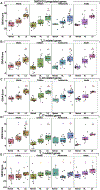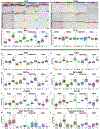The molecular features of normal and atopic dermatitis skin in infants, children, adolescents, and adults
- PMID: 33453290
- PMCID: PMC9285652
- DOI: 10.1016/j.jaci.2021.01.001
The molecular features of normal and atopic dermatitis skin in infants, children, adolescents, and adults
Abstract
Background: Although atopic dermatitis (AD) often presents in infancy and persists into adulthood, comparative characterization of AD skin among different pediatric age groups is lacking.
Objective: We sought to define skin biopsy profiles of lesional and nonlesional AD across different age groups (0-5-year-old infants with disease duration <6 months, 6-11-year-old children, 12-17-year-old adolescents, ≥18-year-old adults) versus age-appropriate controls.
Methods: We performed gene expression analyses by RNA-sequencing and real-time PCR (RT-PCR) and protein expression analysis using immunohistochemistry.
Results: TH2/TH22 skewing, including IL-13, CCL17/thymus and activation-regulated chemokine, IL-22, and S100As, characterized the common AD signature, with a global pathway-level enrichment across all ages. Nevertheless, specific cytokines varied widely. For example, IL-33, IL-1RL1/IL-33R, and IL-9, often associated with early atopic sensitization, showed greatest upregulations in infants. TH17 inflammation presented a 2-peak curve, with highest increases in infants (including IL-17A and IL-17F), followed by adults. TH1 polarization was uniquely detected in adults, even when compared with adolescents, with significant upregulation in adults of IFN-γ and CXCL9/CXCL10/CXCL11. Although all AD age groups had barrier abnormalities, only adults had significant decreases in filaggrin expression. Despite the short duration of the disease, infant AD presented robust downregulations of multiple barrier-related genes in both lesional and nonlesional skin. Clinical severity scores significantly correlated with TH2/TH22-related markers in all pediatric age groups.
Conclusions: The shared signature of AD across ages is TH2/TH22-skewed, yet differential expression of specific TH2/TH22-related genes, other TH pathways, and barrier-related genes portray heterogenetic, age-specific molecular fingerprints.
Keywords: Atopic dermatitis; T(H)2; T(H)22; biomarkers; epidermal barrier; maturation; normal skin; pediatric.
Copyright © 2021 American Academy of Allergy, Asthma & Immunology. Published by Elsevier Inc. All rights reserved.
Conflict of interest statement
Disclosure of potential conflict of interest:
E. Guttman-Yassky is an employee of Mount Sinai and has received research funds (grants paid to the institution) from AbbVie, Celgene, Eli Lilly, Janssen, Medimmune/Astra Zeneca, Novartis, Pfizer, Regeneron, Vitae, Glenmark, Galderma, Asana, Innovaderm, Dermira, and UCB; is also a consultant for Sanofi Aventis, Regeneron, Stiefel/GlaxoSmithKline, MedImmune, Celgene, Anacor, AnaptysBio, Dermira, Galderma, Glenmark, Novartis, Pfizer, Vitae, Leo Pharma, AbbVie, Eli Lilly, Kyowa, Mitsubishi Tanabe, Asana Biosciences, and Promius. J. G. Krueger has received research support (grants paid to his institution) and/or personal fees from Pfizer, Amgen, Janssen, Lilly, Merck, Novartis, Kadmon, Dermira, Boehringer, Innovaderm, Kyowa, BMS, Serono, BiogenIdec, Delenex, AbbVie, Sanofi, Baxter, Paraxel, Xenoport, and Kineta. A. S. Paller has received research support (grants paid to her institution) from AbbVie, Anaptysbio, Celgene, Eli Lilly, Galderma, Incyte, Leo, Janssen, Novartis, and Regeneron and has been a consultant for Almirall, Amgen, Asana, Boehringer-Ingelheim, Castle Creek, Celgene, Dermavant, Dermira, Eli Lilly, Exicure, Forte, Galderma, Lenus, Leo, Novan, Novartis, Pfizer, Regeneron, Sanofi-Genzyme, and Sol Gel. The rest of the authors declare that they have no relevant conflicts of interest.
Figures






References
-
- Silverberg JI. Public health burden and epidemiology of atopic dermatitis. Dermatol Clin 2017;35:283–9. - PubMed
-
- Tsai TF, Rajagopalan M, Chu CY, Encarnacion L, Gerber RA, Santos-Estrella P, et al. Burden of atopic dermatitis in Asia. J Dermatol 2019;46:825–34. - PubMed
-
- Esaki H, Brunner PM, Renert-Yuval Y, Czarnowicki T, Huynh T, Tran G, et al. Early-onset pediatric atopic dermatitis is TH2 but also TH17 polarized in skin. J Allergy Clin Immunol 2016;138:1639–51. - PubMed
-
- Brunner PM, Israel A, Zhang N, Leonard A, Wen HC, Huynh T, et al. Early-onset pediatric atopic dermatitis is characterized by TH2/TH17/TH22-centered inflammation and lipid alterations. J Allergy Clin Immunol 2018;141:2094–106. - PubMed
Publication types
MeSH terms
Substances
Grants and funding
LinkOut - more resources
Full Text Sources
Other Literature Sources
Research Materials

